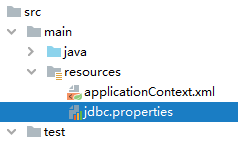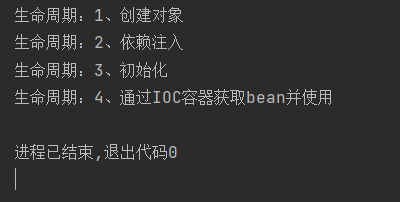目录接前文:Spring:IOC
- 依赖注入之setter注入
- 依赖注入之构造器注入
- 特殊值处理
- 为类类型属性赋值
- 为数组类型属性赋值
- 为集合类型属性赋值
- p命名空间
- 引入外部属性文件
- bean的作用域
- bean的生命周期
- FactoryBean
- 基于xml的自动装配
依赖注入之setter注入
- 创建学生类Student
public class Student{
private Integer id;
private String name;
private Integer age;
private String sex;
//get(),set(),有参,无参,toString
}
- 配置bean时为属性赋值
<bean id="studentOne" class="com.kailong.pojo.Student">
<!-- property标签:通过组件类的setXxx()方法给组件对象设置属性 -->
<!-- name属性:指定属性名(这个属性名是getXxx()、setXxx()方法定义的,和成员变量无关)-->
<!-- value属性:指定属性值 -->
<property name="id" value="1001"></property>
<property name="name" value="张三"></property>
<property name="age" value="23"></property>
<property name="sex" value="男"></property>
</bean>
- 测试
@Test
public void testDIBySet(){
ApplicationContext ac = new ClassPathXmlApplicationContext("applicationContext.xml");
Student studentOne = ac.getBean("studentOne", Student.class);
System.out.println(studentOne);
}
- 测试结果

依赖注入之构造器注入
- 配置bean
<bean id="studentTwo" class="com.kailong.pojo.Student">
<constructor-arg value="1002"></constructor-arg>
<constructor-arg value="翠花"></constructor-arg>
<constructor-arg value="33"></constructor-arg>
<constructor-arg value="女"></constructor-arg>
</bean>
- 测试
@Test
public void testDIBySet(){
ApplicationContext ac = new ClassPathXmlApplicationContext("applicationContext.xml");
Student studentOne = ac.getBean("studentTwo", Student.class);
System.out.println(studentOne);
}
注意:
constructor-arg标签还有两个属性可以进一步描述构造器参数:
- index属性:指定参数所在位置的索引(从0开始)
- name属性:指定参数名
- 测试结果

特殊值处理
字面量赋值
什么是字面量?
int a = 10;
声明一个变量a,初始化为10,此时a就不代表字母a了,而是作为一个变量的名字。当我们引用a的时候,我们实际上拿到的值是10。
而如果a是带引号的:'a',那么它现在不是一个变量,它就是代表a这个字母本身,这就是字面量。所以字面量没有引申含义,就是我们看到的这个数据本身。
<!-- 使用value属性给bean的属性赋值时,Spring会把value属性的值看做字面量 -->
<property name="name" value="张三"/>
null值
<property name="name">
<null />
</property>
注意:
<property name="name" value="null"></property>
这个写法为name所赋的值是字符串null。
xml实体
<!-- 小于号在XML文档中用来定义标签的开始,不能随便使用 -->
<!-- 解决方案一:使用XML实体来代替 -->
<property name="expression" value="a < b"/>
CDATA节
<property name="expression">
<!-- 解决方案二:使用CDATA节 -->
<!-- CDATA中的C代表Character,是文本、字符的含义,CDATA就表示纯文本数据 -->
<!-- XML解析器看到CDATA节就知道这里是纯文本,就不会当作XML标签或属性来解析 -->
<!-- 所以CDATA节中写什么符号都随意 -->
<value><![CDATA[a < b]]></value>
</property>
为类类型属性赋值
- 创建班级类Clazz
public class Clazz {
private Integer clazzId;
private String clazzName;
//get,set,toString,有参无参
}
- 修改Student类
在Student类中添加:
private Clazz clazz;
public Clazz getClazz() {
return clazz;
}
public void setClazz(Clazz clazz) {
this.clazz = clazz;
}
- 方式一:引用外部已声明的bean
配置Clazz类型的bean:
<bean id="clazzOne" class="com.kailong.pojo.Clazz">
<property name="clazzId" value="191"></property>
<property name="clazzName" value="都挣大钱班"></property>
</bean>
为Student中的clazz属性赋值:
<bean id="studentFour" class="com.kailong.pojo.Student">
<property name="id" value="1004"></property>
<property name="name" value="小芳"></property>
<property name="age" value="26"></property>
<property name="sex" value="女"></property>
<!-- ref属性:引用IOC容器中某个bean的id,将所对应的bean为属性赋值 -->
<property name="clazz" ref="clazzOne"></property>
</bean>
错误示例:
<bean id="studentFour" class="com.kailong.pojo.Student">
<property name="id" value="1004"></property>
<property name="name" value="小芳"></property>
<property name="age" value="26"></property>
<property name="sex" value="女"></property>
<property name="clazz" value="clazzOne"></property>
</bean>
如果错把ref属性写成了value属性,会抛出异常: Caused by: java.lang.IllegalStateException:Cannot convert value of type 'java.lang.String' to required type 'com.kailong.pojo.Clazz' for property 'clazz': no matching editors or conversion strategy found意思是不能把String类型转换成我们要的Clazz类型,说明我们使用value属性时,Spring只把这个属性看做一个普通的字符串,不会认为这是一个bean的id,更不会根据它去找到bean来赋值.
方式二:内部bean
<bean id="studentFour" class="com.kailong.pojo.Student">
<property name="id" value="1004"></property>
<property name="name" value="小芳"></property>
<property name="age" value="26"></property>
<property name="sex" value="女"></property>
<property name="clazz">
<!-- 在一个bean中再声明一个bean就是内部bean -->
<!-- 内部bean只能用于给属性赋值,不能在外部通过IOC容器获取,因此可以省略id属性 -->
<bean id="clazzInner" class="com.kailong.pojo.Clazz">
<property name="clazzId" value="2222"></property>
<property name="clazzName" value="全是废物班"></property>
</bean>
</property>
</bean>
方式三:级联属性赋值
<bean id="studentFour" class="com.kailong.pojo.Student">
<property name="id" value="1004"></property>
<property name="name" value="小芳"></property>
<property name="age" value="26"></property>
<property name="sex" value="女"></property>
<!-- 一定先引用某个bean为属性赋值,才可以使用级联方式更新属性 -->
<property name="clazz" ref="clazzOne"></property>
<property name="clazz.clazzId" value="3333"></property>
<property name="clazz.clazzName" value="能吃能喝班"></property>
</bean>
为数组类型属性赋值
-
修改Student类
在Student类中添加:
private String[] hobbies; public String[] getHobbies() { return hobbies; } public void setHobbies(String[] hobbies) { this.hobbies = hobbies; } -
配置bean
<bean id="studentFour" class="com.kailong.pojo.Student">
<property name="id" value="1004"></property>
<property name="name" value="小芳"></property>
<property name="age" value="26"></property>
<property name="sex" value="女"></property>
<!-- ref属性:引用IOC容器中某个bean的id,将所对应的bean为属性赋值 -->
<property name="clazz" ref="clazzOne"></property>
<property name="hobbies">
<array>
<value>抽烟</value>
<value>喝酒</value>
<value>烫头</value>
</array>
</property>
</bean>
为集合类型属性赋值
- 为List集合类型属性赋值
在Clazz类中添加:
private List<Student> students;
public List<Student> getStudents() {
return students;
}
public void setStudents(List<Student> students) {
this.students = students;
}
配置bean:
<bean id="clazzTwo" class="com.kailong.pojo.Clazz">
<property name="clazzId" value="4444"></property>
<property name="clazzName" value="Javaee0222"></property>
<property name="students">
<list>
<ref bean="studentOne"></ref>
<ref bean="studentTwo"></ref>
</list>
</property>
</bean>
若为Set集合类型属性赋值,只需要将其中的list标签改为set标签即可
- 为Map集合类型属性赋值
创建教师类Teacher:
public class Teacher {
private Integer teacherId;
private String teacherName;
//get,set,toString,有参无参
}
在Student类中添加:
private Map<String, Teacher> teacherMap;
public Map<String, Teacher> getTeacherMap() {
return teacherMap;
}
public void setTeacherMap(Map<String, Teacher> teacherMap) {
this.teacherMap = teacherMap;
}
配置bean:
<bean id="teacherOne" class="com.kailong.pojo.Teacher">
<property name="teacherId" value="10010"></property>
<property name="teacherName" value="老耿"></property>
</bean>
<bean id="teacherTwo" class="com.kailong.pojo.Teacher">
<property name="teacherId" value="10086"></property>
<property name="teacherName" value="娟子"></property>
</bean>
<bean id="studentFour" class="com.kailong.pojo.Student">
<property name="id" value="1004"></property>
<property name="name" value="小芳"></property>
<property name="age" value="26"></property>
<property name="sex" value="女"></property>
<!-- ref属性:引用IOC容器中某个bean的id,将所对应的bean为属性赋值 -->
<property name="clazz" ref="clazzOne"></property>
<property name="hobbies">
<array>
<value>抽烟</value>
<value>喝酒</value>
<value>烫头</value>
</array>
</property>
<property name="teacherMap">
<map>
<entry>
<key>
<value>10010</value>
</key>
<ref bean="teacherOne"></ref>
</entry>
<entry>
<key>
<value>10086</value>
</key>
<ref bean="teacherTwo"></ref>
</entry>
</map>
</property>
</bean>
- 引用集合类型的bean
<!--list集合类型的bean-->
<util:list id="students">
<ref bean="studentOne"></ref>
<ref bean="studentTwo"></ref>
</util:list>
<!--map集合类型的bean-->
<util:map id="teacherMap">
<entry>
<key>
<value>10010</value>
</key>
<ref bean="teacherOne"></ref>
</entry>
<entry>
<key>
<value>10086</value>
</key>
<ref bean="teacherTwo"></ref>
</entry>
</util:map>
<bean id="clazzTwo" class="com.kailong.pojo.Clazz">
<property name="clazzId" value="4444"></property>
<property name="clazzName" value="Javaee0222"></property>
<property name="students" ref="students"></property>
</bean>
<bean id="studentFour" class="com.kailong.pojo.Student">
<property name="id" value="1004"></property>
<property name="name" value="小芳"></property>
<property name="age" value="26"></property>
<property name="sex" value="女"></property>
<!-- ref属性:引用IOC容器中某个bean的id,将所对应的bean为属性赋值 -->
<property name="clazz" ref="clazzOne"></property>
<property name="hobbies">
<array>
<value>抽烟</value>
<value>喝酒</value>
<value>烫头</value>
</array>
</property>
<property name="teacherMap" ref="teacherMap"></property>
</bean>
使用util:list、util:map标签必须引入相应的命名空间,可以通过idea的提示功能选择
p命名空间
引入p命名空间后,可以通过以下方式为bean的各个属性赋值
<bean id="studentSix" class="com.kailong.pojo.Student"
p:id="1006" p:name="小明" p:clazz-ref="clazzOne" p:teacherMap-ref="teacherMap"></bean>
引入外部属性文件
- 加入依赖
<!-- MySQL驱动 -->
<dependency>
<groupId>mysql</groupId>
<artifactId>mysql-connector-java</artifactId>
<version>8.0.28</version>
</dependency>
<!-- 数据源 -->
<dependency>
<groupId>com.alibaba</groupId>
<artifactId>druid</artifactId>
<version>1.0.31</version>
</dependency>
- 创建外部属性文件

jdbc.user=root
jdbc.password=123456
jdbc.url=jdbc:mysql://localhost:3306/ssm?serverTimezone=UTC
jdbc.driver=com.mysql.cj.jdbc.Driver
- 引入属性文件
<!-- 引入外部属性文件 -->
<context:property-placeholder location="classpath:jdbc.properties"/>
- 配置bean
<bean id="druidDataSource" class="com.alibaba.druid.pool.DruidDataSource">
<property name="url" value="${jdbc.url}"/>
<property name="driverClassName" value="${jdbc.driver}"/>
<property name="username" value="${jdbc.user}"/>
<property name="password" value="${jdbc.password}"/>
</bean>
- 测试
@Test
public void testDataSource() throws SQLException {
ApplicationContext ac = new ClassPathXmlApplicationContext("spring-datasource.xml");
DataSource dataSource = ac.getBean(DataSource.class);
Connection connection = dataSource.getConnection();
System.out.println(connection);
}
bean的作用域
- 概念
在Spring中可以通过配置bean标签的scope属性来指定bean的作用域范围,各取值含义参加下表:
| 取值 | 含义 | 创建对象的时机 |
|---|---|---|
| singleton(默认) | 在IOC容器中,这个bean的对象始终为单实例 | IOC容器初始化时 |
| prototype | 这个bean在IOC容器中有多个实例 | 获取bean时 |
如果是在WebApplicationContext环境下还会有另外两个作用域(但不常用):
| 取值 | 含义 |
|---|---|
| request | 在一个请求范围内有效 |
| session | 在一个会话范围内有效 |
- 创建类User
public class User {
private Integer id;
private String username;
private String password;
private Integer age;
//set,get,toString,有参无参
}
- 配置bean
<!-- scope属性:取值singleton(默认值),bean在IOC容器中只有一个实例,IOC容器初始化时创建
对象 -->
<!-- scope属性:取值prototype,bean在IOC容器中可以有多个实例,getBean()时创建对象 -->
<bean class="com.kailong.pojo.User" scope="prototype"></bean>
- 测试
@Test
public void testBeanScope(){
ApplicationContext ac = new ClassPathXmlApplicationContext("spring-scope.xml");
User user1 = ac.getBean(User.class);
User user2 = ac.getBean(User.class);
System.out.println(user1==user2);
}
测试结果:

bean的生命周期
具体的生命周期过程
- bean对象创建(调用无参构造器)
- 给bean对象设置属性
- bean对象初始化之前操作(由bean的后置处理器负责)
- bean对象初始化(需在配置bean时指定初始化方法)
- bean对象初始化之后操作(由bean的后置处理器负责)
- bean对象就绪可以使用
- bean对象销毁(需在配置bean时指定销毁方法)
- IOC容器关闭
修改类User:
public class User {
private Integer id;
private String username;
private String password;
private Integer age;
public User() {
System.out.println("生命周期:1、创建对象");
}
public User(Integer id, String username, String password, Integer age) {
this.id = id;
this.username = username;
this.password = password;
this.age = age;
}
public Integer getId() {
return id;
}
public void setId(Integer id) {
System.out.println("生命周期:2、依赖注入");
this.id = id;
}
public String getUsername() {
return username;
}
public void setUsername(String username) {
this.username = username;
}
public String getPassword() {
return password;
}
public void setPassword(String password) {
this.password = password;
}
public Integer getAge() {
return age;
}
public void setAge(Integer age) {
this.age = age;
}
public void initMethod(){
System.out.println("生命周期:3、初始化");
}
public void destroyMethod(){
System.out.println("生命周期:5、销毁");
}
@Override
public String toString() {
return "User{" +
"id=" + id +
", username='" + username + '\'' +
", password='" + password + '\'' +
", age=" + age +
'}';
}
}
注意其中的initMethod()和destroyMethod(),可以通过配置bean指定为初始化和销毁的方法
配置bean:
<!-- 使用init-method属性指定初始化方法 -->
<!-- 使用destroy-method属性指定销毁方法 -->
<bean class="com.kailong.pojo.User" scope="prototype" init-method="initMethod" destroy-method="destroyMethod">
<property name="id" value="1001"></property>
<property name="username" value="admin"></property>
<property name="password" value="123456"></property>
<property name="age" value="23"></property>
</bean>
测试:
@Test
public void testLife(){
ClassPathXmlApplicationContext ac = newClassPathXmlApplicationContext("spring-lifecycle.xml");
User bean = ac.getBean(User.class);
System.out.println("生命周期:4、通过IOC容器获取bean并使用");
ac.close();
}
测试结果:

bean的后置处理器
bean的后置处理器会在生命周期的初始化前后添加额外的操作,需要实现BeanPostProcessor接口,
且配置到IOC容器中,需要注意的是,bean后置处理器不是单独针对某一个bean生效,而是针对IOC容器中所有bean都会执行
创建bean的后置处理器:
package com.kailong.process;
import org.springframework.beans.BeansException;
public class BeanPostProcessor implements org.springframework.beans.factory.config.BeanPostProcessor {
@Override
public Object postProcessBeforeInitialization(Object bean, String beanName) throws BeansException {
//此方法在bean的生命周期初始化之前执行
System.out.println("MyBeanPostProcessor --> 后置处理器 postProcessBeforeInitialization"+ beanName + " = " + bean);
return bean;
}
@Override
public Object postProcessAfterInitialization(Object bean, String beanName) throws BeansException {
//此方法在bean的生命周期初始化之后执行
System.out.println("MyBeanPostProcessor --> 后置处理器 postProcessAfterInitialization" + beanName + " = " + bean);
return bean;
}
}
在IOC容器中配置后置处理器:
<!-- bean的后置处理器要放入IOC容器才能生效 -->
<bean id="myBeanProcessor"class="com.kailong.process.MyBeanProcessor"/>
FactoryBean
- 简介
FactoryBean是Spring提供的一种整合第三方框架的常用机制。和普通的bean不同,配置一个
FactoryBean类型的bean,在获取bean的时候得到的并不是class属性中配置的这个类的对象,而是
getObject()方法的返回值。通过这种机制,Spring可以帮我们把复杂组件创建的详细过程和繁琐细节都屏蔽起来,只把最简洁的使用界面展示给我们。
整合Mybatis时,Spring就是通过FactoryBean机制来帮我们创建SqlSessionFactory对象的。
- 创建类UserFactoryBean
package com.kailong.factory;
import com.kailong.pojo.User;
import org.springframework.beans.factory.FactoryBean;
public class UserFactorBean implements FactoryBean<User> {
@Override
public User getObject() throws Exception {
return new User();
}
@Override
public Class<?> getObjectType() {
return User.class;
}
}
- 配置bean
<bean id="user" class="com.kailong.factory.UserFactorBean"></bean>
- 测试
@Test
public void testUserFactoryBean(){
//获取IOC容器
ApplicationContext ac = new ClassPathXmlApplicationContext("spring-factory.xml");
User user = (User) ac.getBean("user");
System.out.println(user);
}
测试结果:

基于xml的自动装配
自动装配:根据指定的策略,在IOC容器中匹配某一个bean,自动为指定的bean中所依赖的类类型或接口类型属性赋值
场景模拟
创建类UserController:
public class UserController {
private UserService userService;
public void setUserService(UserService userService) {
this.userService = userService;
}
public void saveUser(){
userService.saveUser();
}
}
创建接口UserService:
public interface UserService {
void saveUser();
}
创建类UserServiceImpl实现接口UserService:
public class UserServiceImpl implements UserService {
private UserDao userDao;
public void setUserDao(UserDao userDao) {
this.userDao = userDao;
}
@Override
public void saveUser() {
userDao.saveUser();
}
}
创建接口UserDao:
public interface UserDao {
void saveUser();
}
创建类UserDaoImpl实现接口UserDao:
public class UserDaoImpl implements UserDao {
@Override
public void saveUser() {
System.out.println("保存成功");
}
}
配置bean
使用bean标签的autowire属性设置自动装配效果。
自动装配方式:byType。
byType:根据类型匹配IOC容器中的某个兼容类型的bean,为属性自动赋值,若在IOC中,没有任何一个兼容类型的bean能够为属性赋值,则该属性不装配,即值为默认值null。若在IOC中,有多个兼容类型的bean能够为属性赋值,则抛出异常NoUniqueBeanDefinitionException。
<bean id="userController" class="com.kailong.controller.UserController" autowire="byType"></bean>
<bean id="userService" class="com.kailong.service.impl.UserServiceImpl" autowire="byType"></bean>
<bean id="userDao" class="com.kailong.dao.impl.UserDaoImpl"></bean>
自动装配方式:byName
byName:将自动装配的属性的属性名,作为bean的id在IOC容器中匹配相对应的bean进行赋值
<bean id="userController"class=""com.kailong.controller.UserController" autowire="byName">
</bean>
<bean id="userService"class="com.kailong.service.impl.UserServiceImpl" autowire="byName">
</bean>
<bean id="userServiceImpl"class="com.kailong.service.impl.UserServiceImpl" autowire="byName">
</bean>
<bean id="userDao" class="com.kailong.service.impl.UserDaoImpl">
</bean>
<bean id="userDaoImpl" class="com.kailong.service.impl.UserDaoImpl">
</bean>
测试
@Test
public void testAutoWireByXML(){
ApplicationContext ac = new ClassPathXmlApplicationContext("spring-autowire-xml.xml");
UserController userController = ac.getBean(UserController.class);
userController.saveUser();
}
测试结果:

公众号本文地址:https://mp.weixin.qq.com/s/YTAxDW4EgsiVQWHlNCPdtA
欢迎关注公众号愚生浅末。
